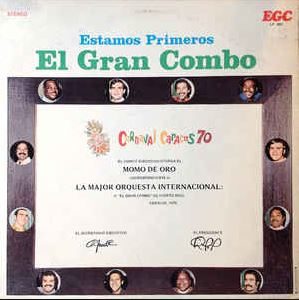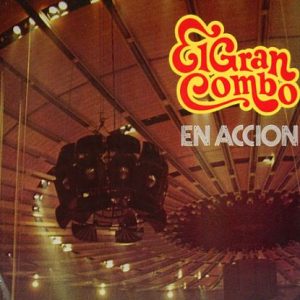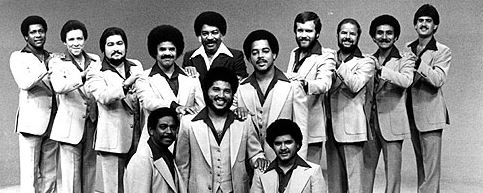This post is also available in:
 Español
Español
El Gran Combo of the early ’70s is very different than that of the ’60s, and by the late 70s it would look totally different again. However, they kept going as if nothing had happened and exited the 70’s a stronger combo.
New Decade, New Record Label
The 70’s started for El Gran Combo with immediate changes. GEMA, their record label through the ’60s, decided not to renew their contract. Rafael Ithier began negotiations with various record labels, including the prestigious Motown, which had amassed 110 top 10 hits from 1961 to 1971, with recording artists like The Jackson 5, The Supremes, and Stevie Wonder among many others.

None of the negotiations barred fruit, and El Gran Combo opted for forming its own record label. In order to do that they needed some capital to get off the ground. Andy Montañez took the initiative and the risk to mortgage his house in order to get the label off the ground.
“Estamos Primeros” (We’re First) was the first album under their new record label “EGC Records”, which towards the end of the decade would change names to Combo Records in association with Ralph Cartagena.
The video clip below is a bit out of sequence in this blog as the song “Julia” was part of the third album of the ’70s titled “Por El Libro” (1973). It was the last album in which Pellín Rodriguez would participate. By the time El Gran Combo performed the song in 1973 at the Yankee Stadium, Charlie Aponte had replaced Pellín in the combo. The clip was part of the movie “Salsa“.
Andy Montanez Becomes the Voice of El Gran Combo
In the early to mid-60s, Pellín Rodriguez was the voice of El Gran Combo. Andy Montañez and Pellín had about equal billing in the band. Pellín sang the boleros and merengues, and both would split the guarachas. But since there were more guarachas in the albums than boleros and merengues combined, Andy ended up singing as many or slightly more songs as Pellín. However, due to his flashy and comedic personality, and his on-stage MC skills, Pellín was the voice of El Gran Combo.
Through the 60’s Andy’s voice matured. It became stronger, and his technique improved, giving him even more songs to sing, including more boleros. By the early 70s, Andy had taken over as the voice of el Combo. He was singing all the boleros and his guarachas (son montunos known as “salsa“) were the most popular on the radio.
El Gran Combo Adds “La Bara” and New Chorus
In 1971, Rafael Ithier wanted to make the sound of El Gran Combo more robust and modern to better compete with the Salsa sound coming out of New York. He decided to add a trombone to the brass section, and so in 1971, he hired Epifanio “Fanny” Ceballos. The first album with the new sound was “De Punta a Punta” (1971) which included the hits “Achilipú“, “Le Dicen Papá“, and “Don Goyo“. That has been the only change El Gran Combo has done to its musical format.
Another change introduced to the recordings at this time was the addition of reinforcements for the chorus. At first, it was mainly Paquito Guzmán, who also had done chorus for Bobby Valentín and others while being the lead singer of Tommy Olivencia’s orchestra. Paquito is one of the best “coristas” in Salsa and brought a unique sound to the band’s recordings.
Here’s a clip of the song “Achilipú” where the trombone makes its debut in the brass section, and Paquito Guzmán helps in the chorus.
Pellín Rodriguez “En Acción”, Out of El Gran Combo
Pellín, who had seen his role in El Gran Combo diminish, decided to do a little moonlighting singing boleros. In 1973, the Borinquen Records label approached Pellín Rodriguez and signed him to a contract. When Rafael Itheir found out, he was not happy. Pellín assured Ithier that singing boleros would be a side job and that he would continue singing with El Gran Combo.

I believe Pellín must have thought of the precedent established by Roberto Roena, who had formed Los Megatones to play Latin Jazz on the side on Wednesdays, and thought there was nothing to it. If Roena did it, why not him?
We must also consider that Pellín’s participation in el Combo recordings was diminishing. In the early to mid-60s, Pellín would sing 4 or 5 songs per album. In the last 3 LPs of the ’60s, he was down to 3 songs per LP. Then, in the first 3 LPs of the ’70s, Pellín was down to 2 songs per album. Also add the fact that he had not recorded a bolero since 1967 (five years earlier) in the album “Pata Pata, Jala Jala, Boogaloo“.
Nonetheless, Ithier did not agree with Pellín’s idea and that meant the (forced) departure of Pellín Rodriguez from El Gran Combo, and therefore, the launch of his solo career.
This incident occurred while El Gran Combo was rehearsing the material for the upcoming album “En Acción” (In Action – 1973). In the video clip below, you can see Pellín Rodriguez in one of his last TV appearances with El Gran Combo on the song “El Guaguancó del Gran Combo“. If you noticed, the original lyrics went…”...cantarán Pellín y Andy, dile a Eddie que responda…“. In the recorded version (since Pellín was gone and a replacement had not been found), the lyrics go “…seguirá cantando Andy, dile a Eddie que responda…“.
Charlie Aponte Joins El Gran Combo “Con Güiro y Pandereta”
It wasn’t Christmas yet, but Charlie Aponte joined El Gran Combo for the album “El Gran Combo 5” (also launched later in 1973), which was the 2nd Christmas album for el Combo, since its 1966 hit album “En Navidad“. This couldn’t have been scripted better for Charlie, who loves to sing “Aguinaldos” and folk Puerto Rican music.
There were many talks about Pellín’s departure, how he was still the “face”, even if not the “voice”, of El Gran Combo. Charlie had big shoes to fill.
Charlie Aponte was an immediate hit with El Gran Combo. He had a strong and unique voice and quickly learned Mike Ramos dance routines. Charlie was assigned to record the Puerto Rican Christmas classic “Si No Me Dan de Beber, Lloro“, which became a big hit for the album.
Andy Montañez Leaves “Buscando Ambiente”
The Changes would not stop for El Gran Combo. With Pellín’s departure, Andy sang the whole album “En Acción“. As he matured, he more and more identified with El Gran Combo. When news circled that he had been offered a juicy contract in Venezuela to replace Oscar D’León in La Dimension Latina, the public began predicting the fall of El Gran Combo.
People thought that even if the band did survive Andy’s departure, it would never again be the premier Salsa music band they had been with Andy behind the microphone. They would become just another band with another singer.
The band did suffer a dip in the first album without Andy, who left in 1977 after the album “Mejor Que Nunca” (Better Than Ever), but “Los Mulatos del Sabor” would recover and would find their stride once again.
Here’s a clip of Andy Montañez singing the hit “La Soledad” from the album “Mejor Que Nunca”
“No Necesito Nada” – Jerry Rivas Joins El Gran Combo
Rafael Ithier moved quickly to replace Andy Montañez, and found a young talent in Jerry Rivas. Jerry had a deep low voice, which would pair well with Charlie Aponte’s higher-pitched voice.
As is well known, Ithier doesn’t take departures very well. The song “Buscanado Ambiente” (a song about a romantic breakup) was used as a “tiraera” (throw indirect insults) towards Andy Montañez. Andy responded in the Dimension Latina song “Cantante Errente” saying “yo me fui buscando ambiente, porque aquí el ambiente es bueno” (I left seeking new ambiance, because here the ambiance is good). This wouldn’t be the last of the “tiraera” between el Combo and Andy.
The first album with Jerry Rivas was “Internacional” (1977), which was not as well-received as previous albums. But by the next album, Jerry was feeling more at home, and “En Las Vegas” (1978) turned out to be an excellent album.
Here’s a video clip shortly after Jerry Rivas joined el Combo during a performance on one of Luis Vigoreaux’s (father) TV shows in Puerto Rico.
Finishing the 70’s Strong
In addition to changing both singers, losing their record label, and adding a trombone to their lineup, El Gran Combo had other personnel changes, particularly in the percussion section. As I mentioned in the previous part, Roberto Roena left in ’69 to form the Apollo Sound.

It was not until 1977, when conga player and founding member Martín Quiñonez left, around the time Andy left, due to the complications of a car accident in which he was involved. His son, Martín Quiñonez Jr., replaced him for a couple of years, but then he left in ’79, being replaced by Miguel “Pollo” Torres.
Then in 1979, timbalero Mike “Malaret” Marrero left due to health issues, being replaced by Edgardo Morales who came from Tommy Olivencia via La Sonora Ponceña.
In the bass, founding member Miguel Cruz retired in 1975 being replaced by the young Fernando Perez (who is also featured as part of the new crop of el Combo in the Luis Vigoreaux clip with Jerry Rivas).
In the trumpet, Gerardo “Grillo” Cruz left in ’79 and was replaced by Nelson Feliciano. Feliciano would have a short stay in the band as we’ll see in the 80s.
I think you get the picture that the ’70s were a decade of many changes. Despite that, El Gran Combo released 12 albums, including 2 Christmas albums, and finished the decade strong with two great albums. The first was “En Las Vegas” (1978), which had the second and perhaps more purposely “tiraera” song for Andy Montañez in “Aquí No Ha Pasado Nada” (Nothing’s Happened Here), and the last one was “Aquí No Se Sienta Nadie” (1979), where Jerry Rivas really won Salsa fans with songs like “Así Son” and “Adela“.
In these albums, Yayo El Indio took over the chorus reinforcement duties from Paquito Guzmán and did an extraordinary job.
With that, El Gran Combo just needed some stability. Will they finally find that stability in the 1980s?

